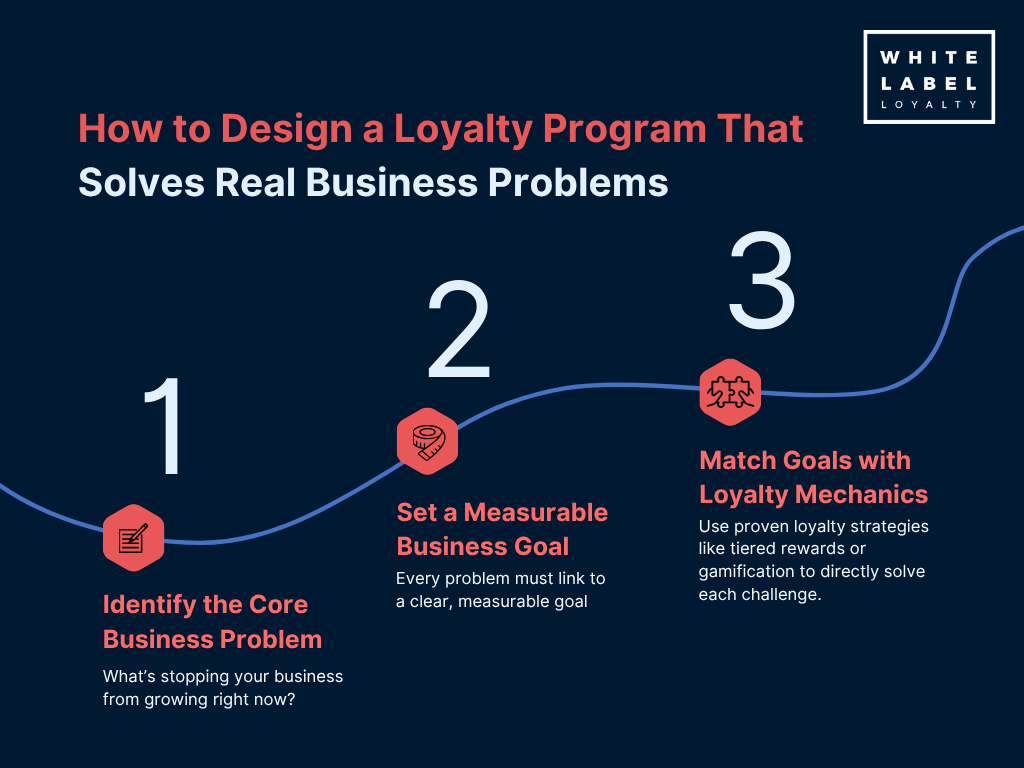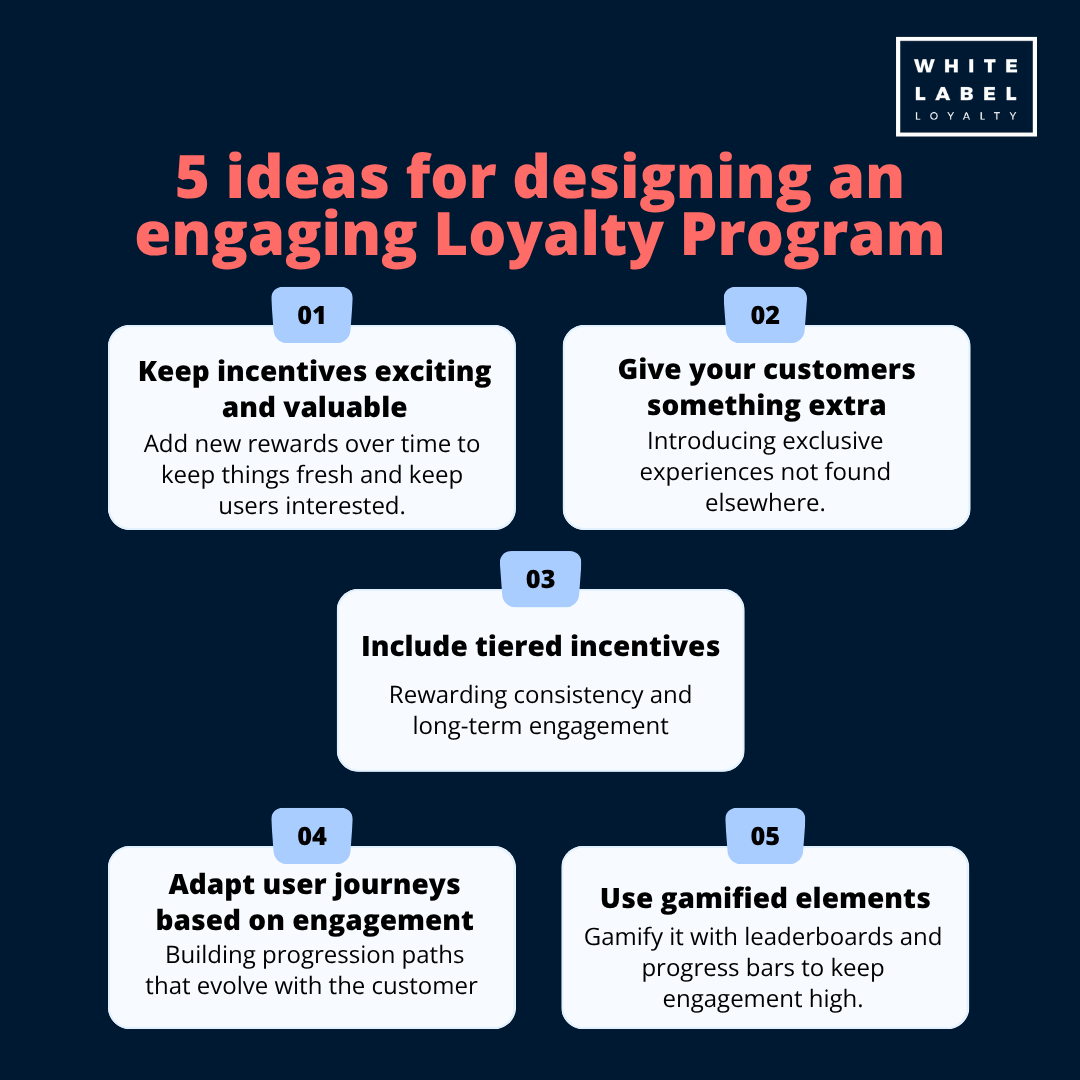How to Design a Loyalty Program That Solves Real Business Problems
When businesses launch loyalty programs, they often start with a vague idea: “We want customers to earn and spend points.” But that’s not a strategy - it’s a feature!
The most successful loyalty programs aren’t defined by points, tiers, or gamification. They’re designed with a clear business objective in mind. Whether your goal is to increase average transaction value (ATV), improve customer retention, boost engagement, or capture first-party data, your loyalty program should solve a real business problem.
This article provides a step-by-step guide on how to create a goal-driven, ROI-focused, scalable loyalty program strategy.
If you're searching for how to design a loyalty program that works, increases customer retention, or drives higher average spend, this guide will help you turn customer incentives into measurable growth.
Step 1: Identify the Core Business Problem
Ask yourself: What’s stopping your business from growing right now?
A strategic loyalty program targets a specific challenge. Common problems include:
- Low Average Transaction Value (ATV): Customers are spending less per visit than you’d like.
- Poor Customer Retention: First-time buyers don’t return.
- Low Engagement: Customers only interact at checkout; there’s no brand connection.
- Negative Experience: Customer journeys feel impersonal or transactional.
- Lack of First-Party Data: You don't have enough insight into customer behavior.
Example: PepsiCo, an FMCG brand selling into retailers, has no direct POS access and therefore lacks first-party customer data. This lack of data means that PepsiCo struggles to get clear insights into customer behavior.
Step 2: Set a Measurable Business Goal
Every problem must be linked to a clear, measurable goal. This is the foundation of loyalty program success. Here's some examples of problems mapped to measurable goals:
- Problem: Low ATV → Goal: Increase basket size → Measurement: % Increase in ATV
- Problem: Poor retention → Goal: Boost repeat purchases → Measurement: Repeat purchase rate within x days
- Problem: Low engagement → Goal: Increase brand interaction → Measurement: Increase of non-transactional actions (e.g. reviews, shares, app interactions)
- Problem: Weak experience → Goal: Improve customer satisfaction & loyalty → Measurement: Net Promoter Score (NPS)
- Problem: No data → Goal: Capture first-party data → Measurement: Number of users with completed data profiles
Example: PepsiCo needs to collect detailed customer data, right from the source. Their goal was to capture first-party data on a large scale:
- Problem: No data → Goal: Capture first-party data via incentivized receipt scanning → Measurement: Number of receipt scans
Step 3: Match Goals with Loyalty Mechanics
Now, map each goal to specific program features:
Goal: Increase ATV
- Tiered incentives: "Spend £50, get 100 points. Spend £75, get 150 points."
- Threshold rewards: Cashback or discounts at higher spend levels
- Next-purchase perks: "Spend £100, get 10% off your next order"
Goal: Improve Customer Retention
- Milestone rewards (e.g., after 3rd, 5th, or 10th purchases)
- Progressive tiers or VIP levels
- Personalized incentives based on engagement levels
- Predictive churn-based offers triggered by analytics
Goal: Boost Engagement
- Reward non-transactional actions (e.g., reviews, referrals, app installs, social follows)
- Launch gamification mechanics like spin-to-win, badges, or streak-based rewards
Goal: Improve Customer Experience
- Let users choose rewards (e.g., merch, gift cards, charity donations)
- Offer personalized offers based on behavior
- Celebrate moments like birthdays or anniversaries
Goal: Capture First-Party Data
- Use incentivized receipt scanning or QR codes to capture purchases without needing POS access
- Reward customers for profile completion, surveys, or permissioned marketing data
Example: PepsiCo enters users into competitions to win prizes whenever they scan a receipt.

The above 3-step framework helps you design a loyalty program that is focused on actually delivering measurable business impact. To summarize:
- Identify the Core Problem: Understand what’s limiting growth - low average spend, poor retention, weak engagement, bad experience, or lack of first-party data.
- Set a Measurable Goal: Link each problem to a clear KPI - like increasing basket size, boosting repeat purchases, or capturing customer data at scale.
- Match Mechanics to Goals: Use proven loyalty strategies like tiered rewards, milestone incentives, gamification, personalized offers, and receipt scanning data capture to directly solve each challenge.

Loyalty Program Design: Best Practices
Even the smartest loyalty strategy can fall flat if the program is confusing, hard to use, or doesn’t feel valuable to the customer. The best loyalty programs are clear, frictionless, and built around what people actually want. Here’s how to get the basics right:
What to Do
- Make the rewards logic simple and clear
- Focus on customer value, not just business goals
- Keep actions easy and rewards achievable
- Use segmentation to personalize rewards and messaging
What to Avoid
- Overcomplicating rules or tiers
- Making users guess what they get or how
- Requiring too much effort to redeem
- Using discounts as your only value lever
Top Tip: Designing for Long-Term Loyalty
Quick wins are great - but the real ROI of loyalty programs comes from long-term customer relationships. Your loyalty strategy needs to deepen emotional connections, and scale as your customer base grows. Consider:
- Adding new rewards over time to keep things fresh
- Introducing exclusive experiences not found elsewhere
- Rewarding consistency and long-term engagement
- Building progression paths that evolve with the customer
- Gamifying the experience to keep engagement high

Conclusion
The best loyalty programs don’t start with features. They start with a question: What business problem are we trying to solve?
From there, everything becomes clear: the objective, the loyalty mechanics, and the customer experience.
Remember:
- Start with the challenge
- Keep the design simple
- Focus on customer value
- Build for long-term growth
- Track ROI using data-driven metrics like retention rate, ATV, lifetime value, and program adoption
→ Get in touch with a loyalty expert
Turn your loyalty program into a strategic growth driver - not just another marketing feature.
Recommended Posts
If you enjoyed this article, check out these relevant posts below.
Share this Article

Helen Walker
Product Marketing Manager
Helen is our Product Marketing Manager.